The wonderful words of beer
Have you ever wondered where the word beer came from, what we called the drink, in English before we used the word beer, and, for that matter, if the drink was any different when it was called by another name?
Have you ever wondered where the word beer came from, what we called the drink, in English before we used the word beer, and, for that matter, if the drink was any different when it was called by another name?
Introduction to the podcast and my goals and aspirations around it.
I hope that you will join me on this journey to explore the history of beer and brewing in general, as well as some focus on the current goings-on in craft beer culture.
Drink what you love!
After weeks of warmer than usual weather, spring has returned! It makes me think I should have saved that stout from a couple of weeks ago. Oh well, there’s nothing wrong with a little light beer on a rainy evening, and Oso Brew know how to make light beers too. I think I remember their table beer from a Beermad of the past, now canned in a hot and swimsuit worthy color. Mesa ought to be just the thing you’re ready to grab whatever the weather.
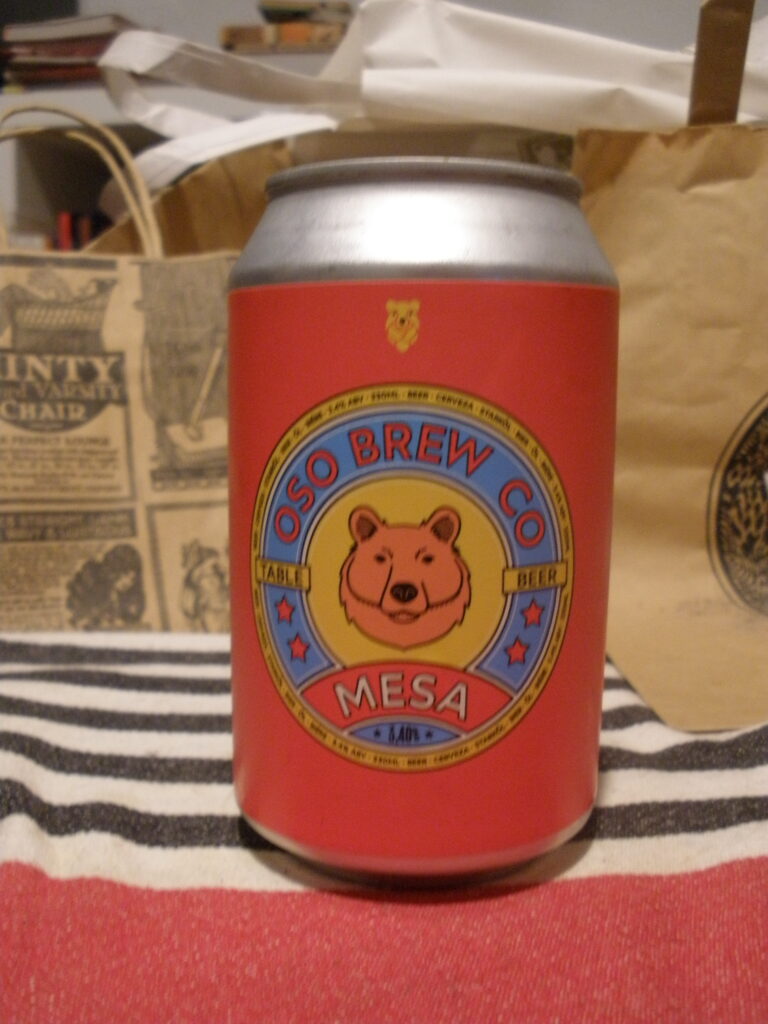
It’s a summery gold color and the head is a clean white while it lasts. There are promises of IPA-like fruit aromas, and there is a good whiff of citrus and maybe pineapple. It has a full beer flavor with just a touch of fruit, less bite-y than the aforementioned, more like mango or watery peach. There’s a strong breadiness that rushes out ahead of the end of the swallow and sticks around for a while after. The beer itself has a very light feel, predictable for its less than 4% alcohol, but the aftertaste makes it feel like a more corpulent one, with more presence than a beer that banks on its low ABV to be appealing. It certainly feels like a beer that could be at the table – a pre-meal drink, a midday break, the beverage of choice at dinner are all believable.
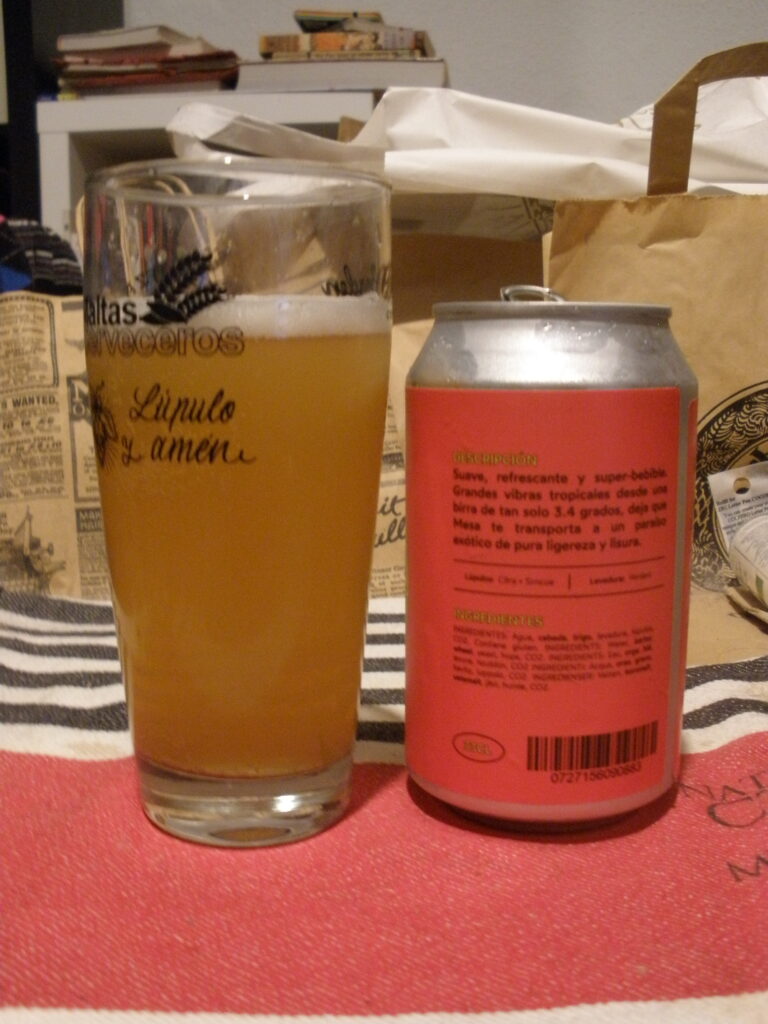
Supplier: La Mundial
Price: €4
After a beer fair you might not want to go back to the same old, same old. Garage is a very familiar and beloved brewery, but they do have a few special things in their cans. I have had Barcelona Weisse before, but in a different iteration; this is the 8th anniversary version, with a collectable sticker on the can. Calvell 45 does its best to bring you in, with a list of tropical fruits promising a bouncier, more colorful weisse.
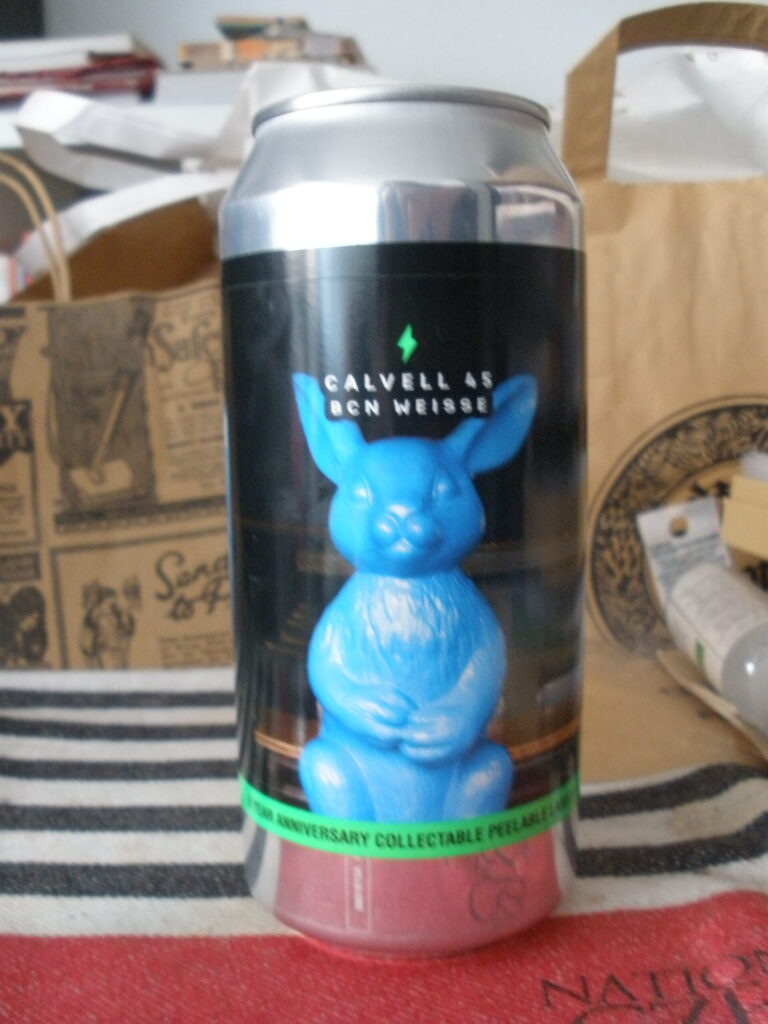
Can seems extra full and aroma is extra fruity. It has a distinct mandarin scent to it, and while it does pour out fizzy, the liquid looks a lot like mandarin juice from a can. Well, a little more color, Fanta thinned with mandarin juice. The head dies back immediately although tiny bubbles continue to rise. The first sip starts out thick and much more bitter than expected, rolling over to a more citrusy tang, and ending on an orange pith note. The weisse kind of sour actually takes a couple of sips to come out. It’s that blend of bitter and sour that weisses tend to have, with a touch more fruit than the traditional ones offer. It’s very light in the mouth, effervescent even, with sort of a champagne feel; it might be a good substitute for a beer focused celebration. Now that temperatures are reasonable for the time, I’m wishing I had more good stouts, like were at Beermad, but you really can’t complain with Garage.
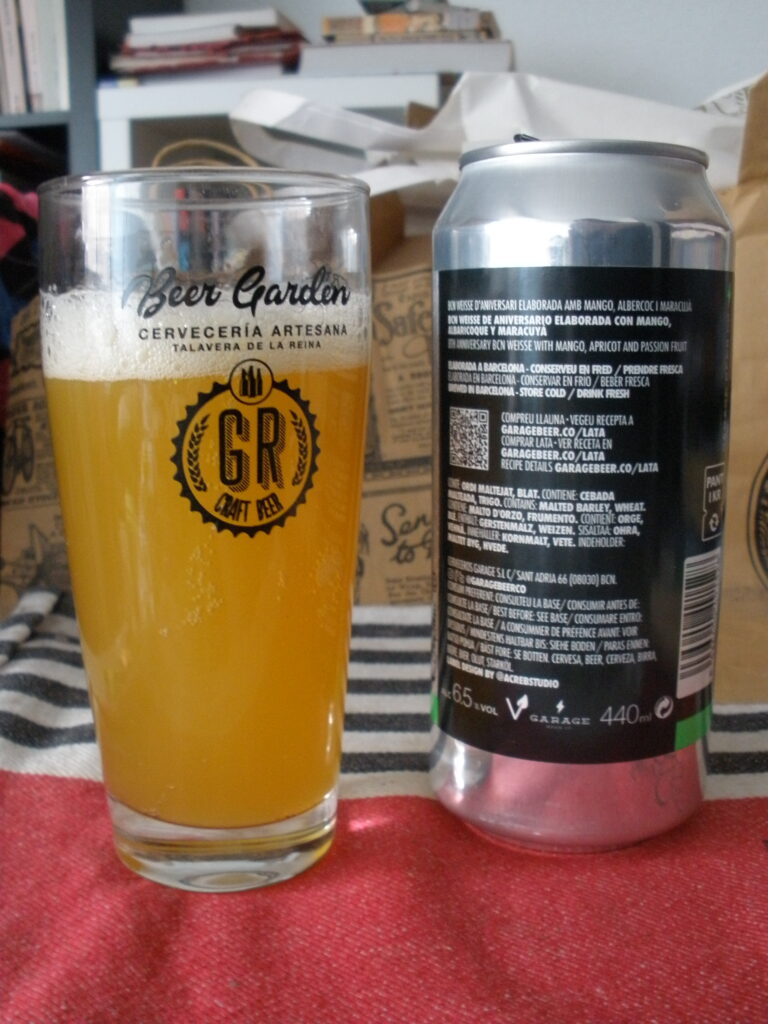
Supplier: La Mundial
Price: €6.50
Beermad is back to its regular schedule it looks like, and this time they’re making the most of a local holiday weekend to have four days instead of the normal three. It’s still at Casa de Campo, still somewhat limited entry, although there are morning and afternoon passes, plus all-day passes this time around. Unsociable person that I am, I go in the morning, when fewer people are looking to really drink down some beers, and of they’re there it’s really to enjoy the experience.
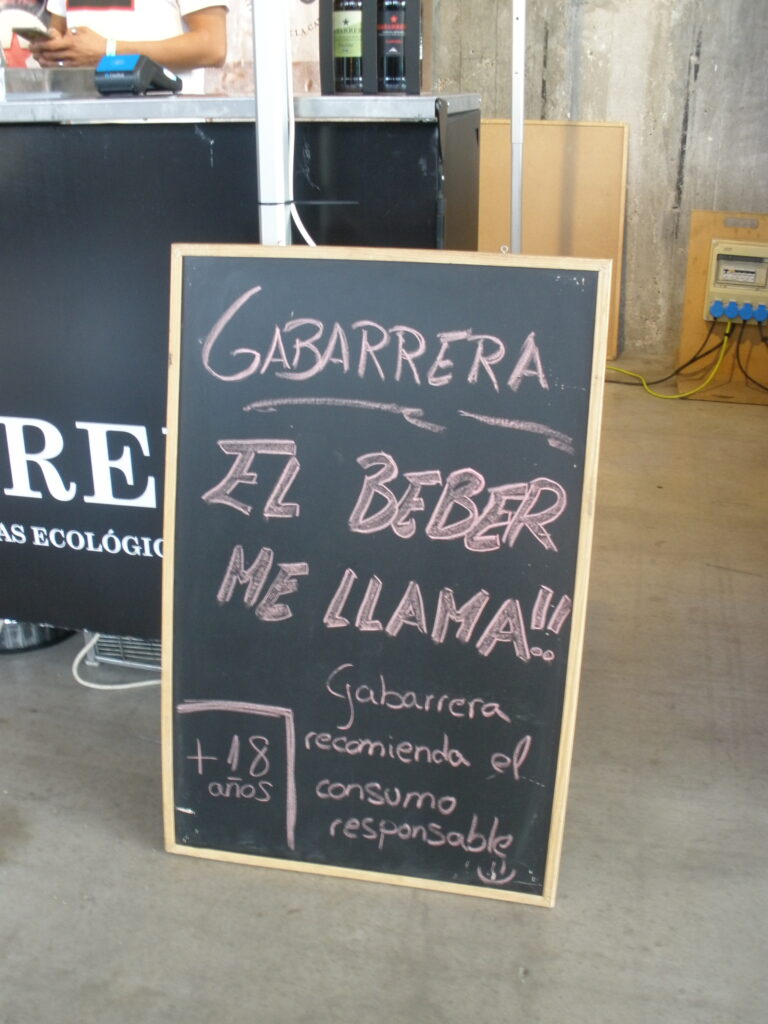

I always start on the dark side; just that kind of girl I guess. There are more to choose from than in other editions, but the first one I lay eyes on is a real licker too: Toccalmatto’s 28 Imperial Stout. They specialize in making low-carb beers and this one is also no added sugars, just the natural malts. That sounds like a pretty normal stout, but it also has some chipotle that you might think needs a but of balancing. Happy to try it out! It smells a little winey, but there’s a good thick head. The color is slightly lighter than I expect from stout. The taste is woody, malty, leafy, very nature-focused. I would even call it a healthy flavor. As promised, there’s a touch of chili. It’s a 12%-er, so the lightness in the mouth is surprising, and the alcohol does catch up to you if you’re not careful. It’s a chili-chocolate sensation, only slightly bitter, and could be hard to beat today.
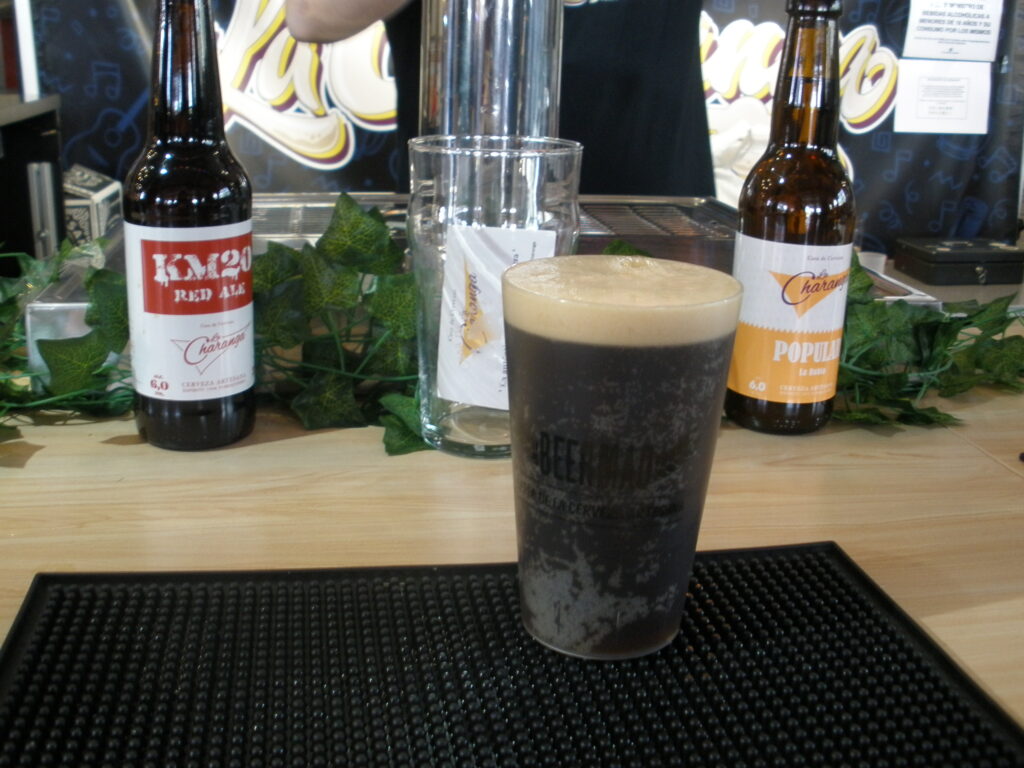
Next I ask for Vandalia’s Azabache Porter. This one isn’t on tap, the lack of head is probably my own poor pouring skills. It’s fizzy and with a nice porter color, with a kind of root beery, vaguely sour fruit smell. This porter also has a woody flavor, but a different kind, more robust. It’s drier than the stout and not very fruity for a porter. While solid and mouth filling, it doesn’t make you think of road tar (“azabache”), it’s quite easy on the palate and would even be a good accompaniment to a meal.
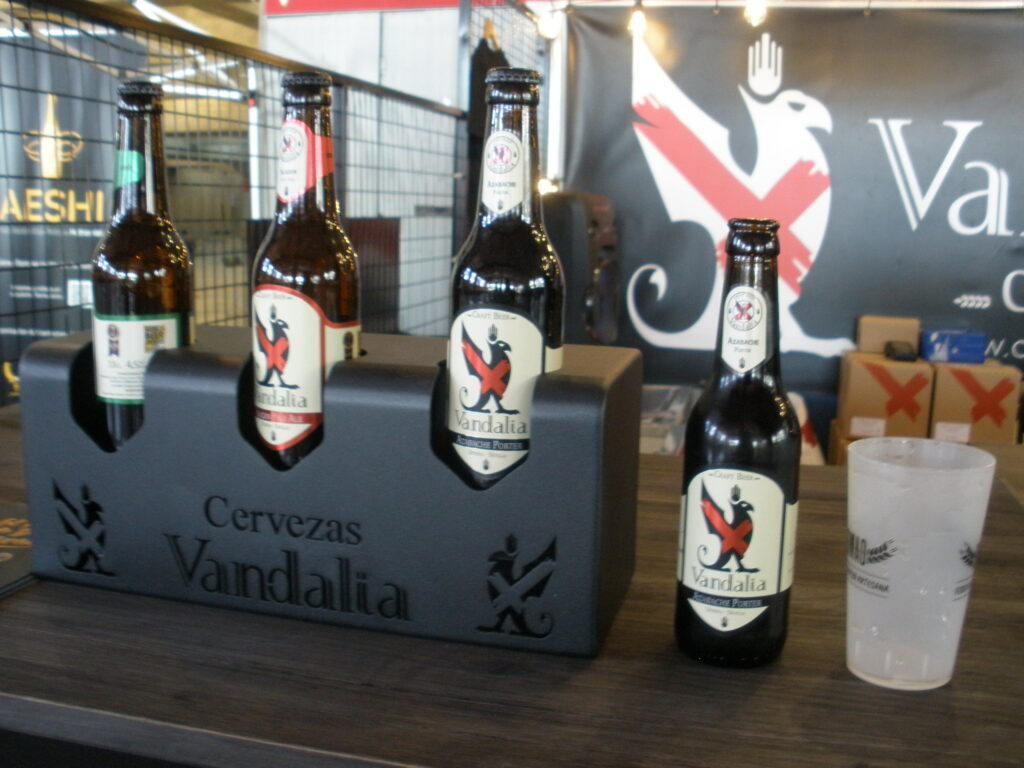
My quest for the darkness continues with La Charanga’s 28850 Stout. Also little head (and I didn’t pour this time), but otherwise good appearance. No strong aromas off this one. It’s very malty and slightly smoky, with an underlying bitter just lurking. It has more body than the previous beers, a little sticky and moderately heavy. Notes of licorice and coffee surface over time. It is a nice beer, more imposing than Vandalia’s porter but simpler in presentation than Toccalmatto.
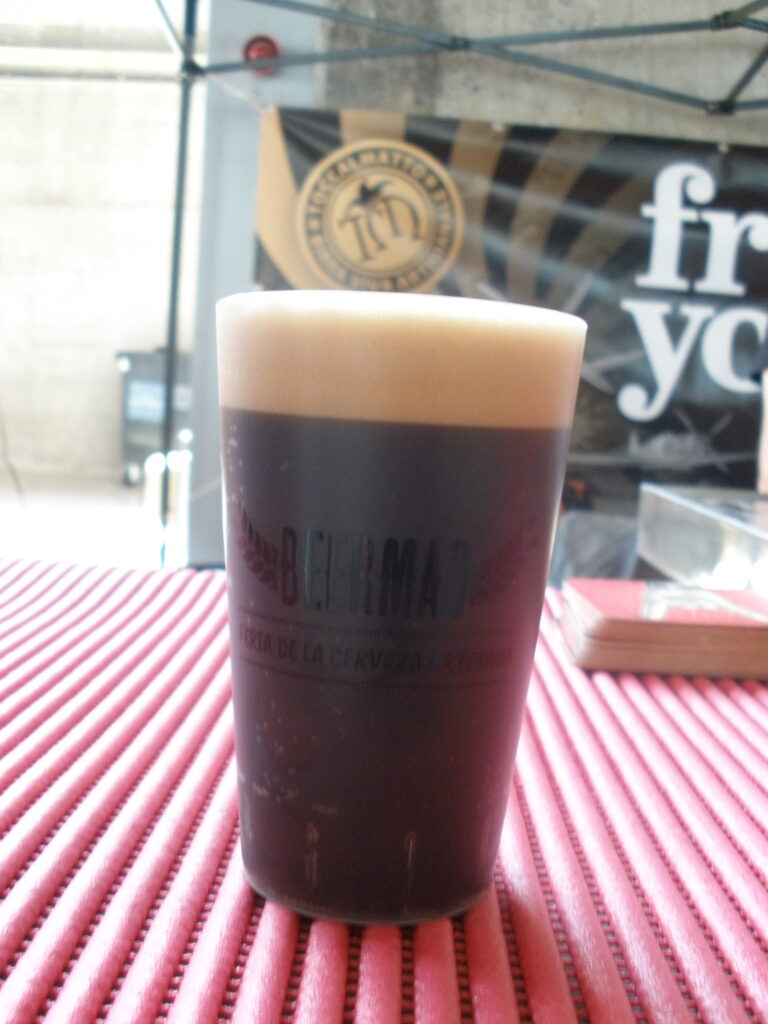
It turns out I’m not impervious to a good invitation. While I could have stuck to black beers, From Lost to the River offered a taste of all three of their beers before making a decision (none were stouts) and I couldn’t resist. There was an English bitter style – very nice – a light and normal IPA, and a very hop forward dry hopped version. I had to have something to equal those powerful black beers from before, so that was Lost IPA, with some more hops behind it. It’s very golden, little head, and sports a bubbly hop aroma. It’s not actually super bitter but very modern hoppy, juicy, with a little bit of peach. You get a good mouthful of beer rather than a poof of overwhelming hops that claw their way down your throat. It’s a bright and blinky beer, styled more as a West Coast IPA than other types, and I would call it fairly standard for IPAs today. I would also say there’s a reason for that being standard.

I only have a morning ticket, so I can’t stay forever. I do have plenty of time for one more, though, and I usually feel like I should leave on a light note. I was intrigued by Cervecería La Política and thought that might be a good closer. I was hoping for a big story about one party or another, but it seems like they’re just playing off the current feeling of dissociation. Anyway, another IPA, fitting aroma and good strong head. Faintly opaque. It’s very much a normal IPA, hoppy, biting-bitter, floral soft and clean. A finishing beer, really, although it does have a hint of dust in it. It feels like a quick gulp and a soft swallow, very easy on the tongue and yet it still has a certain amount of personality to put forward. I only wonder what kind of politics might be represented by the color on the label…
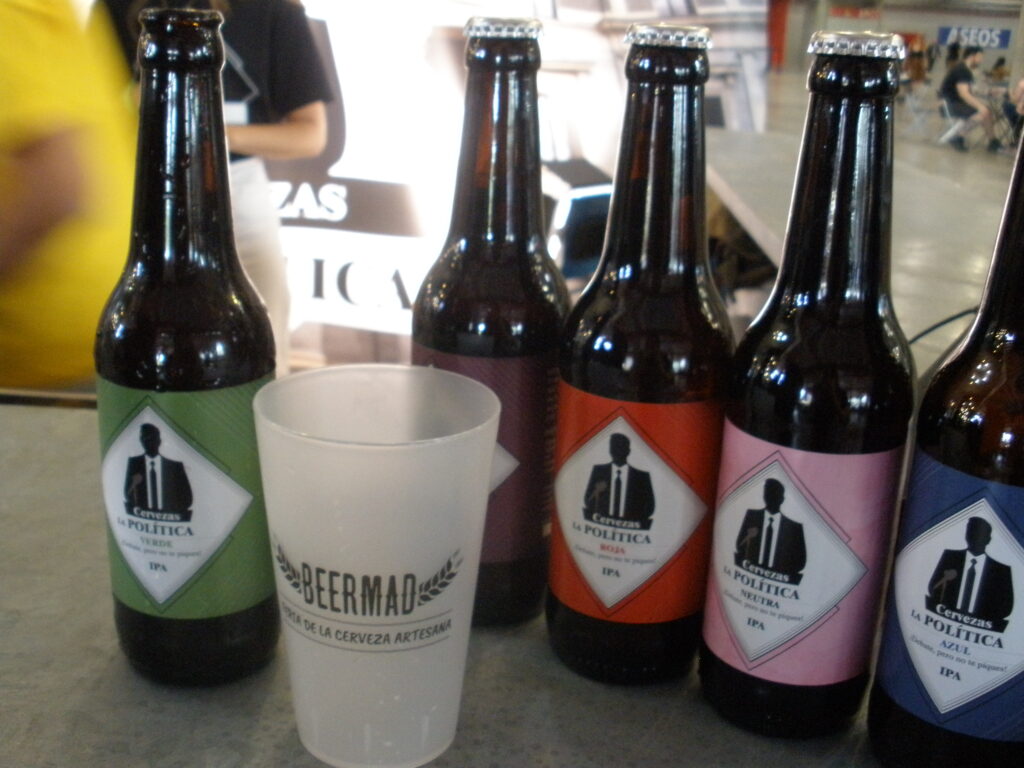
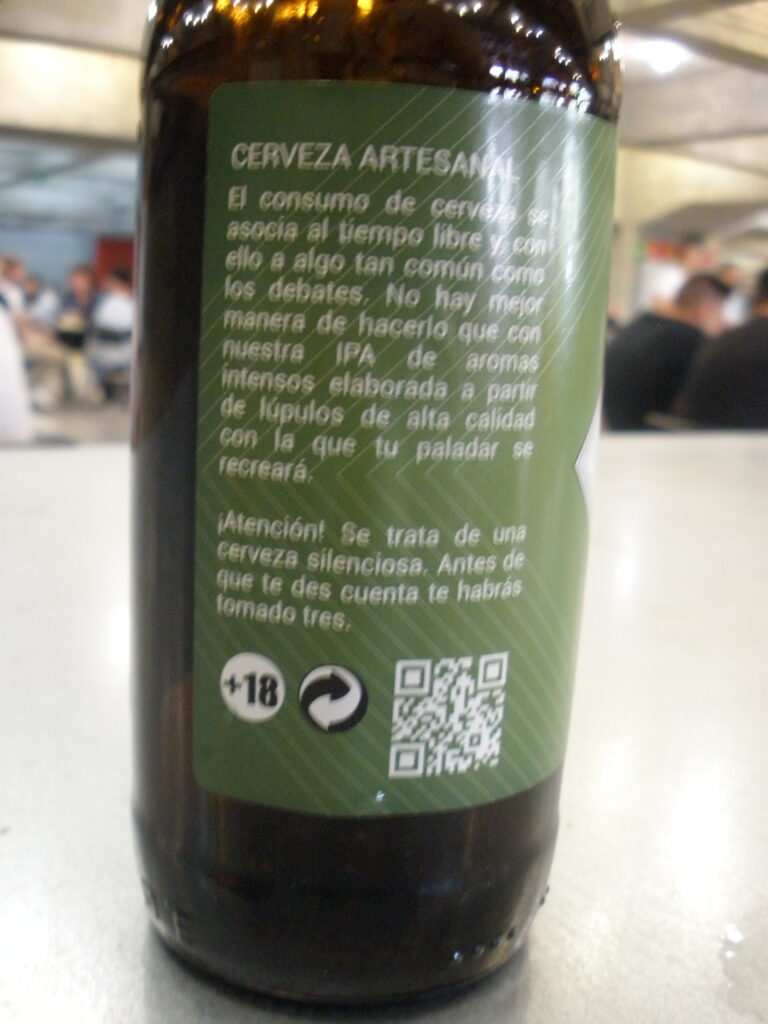
It’s an early summer, but damn if I won’t find a stout to go with my weekend. La Mundial recommends Cierzo’s Colossus, an imperial stout at a hefty 10%. I hope the shade of the beer will have some kind of placebo effect and give me the illusion of being in the shade, with a cool breeze keeping things civilized. As it is, I have some serious worries about keeping comfortable in July. We keep hearing promises that there won’t be restrictions on water usage, but once elections pass anything goes, I bet.
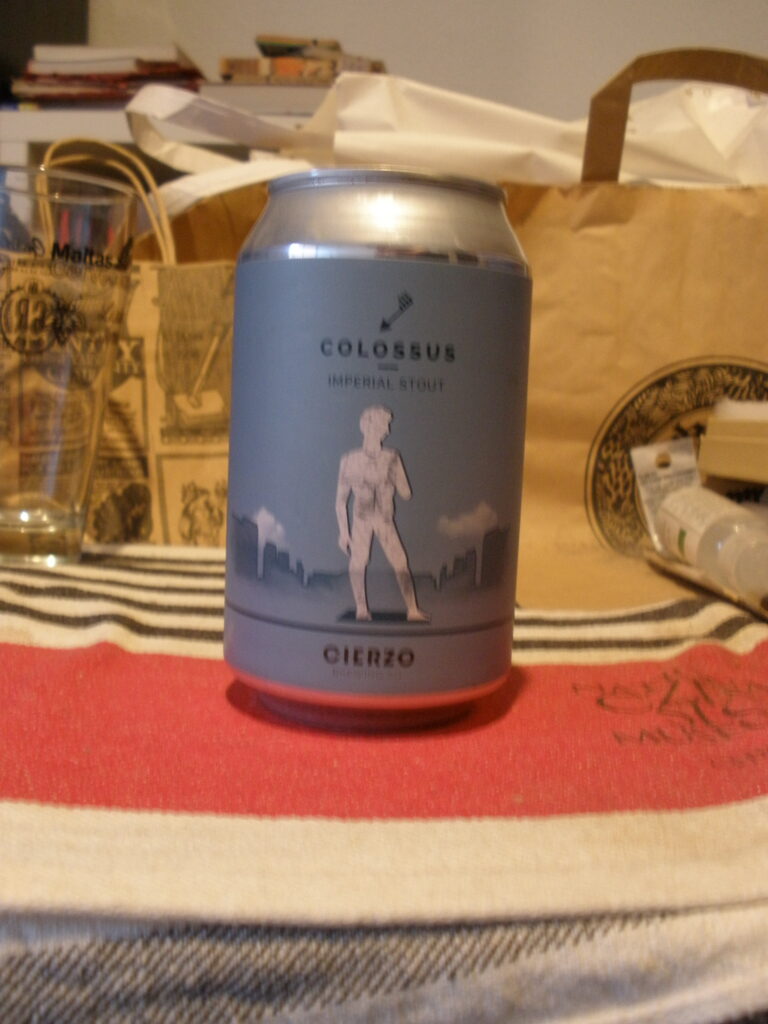
A little more shook up than it should be, but that might be the excessive temperatures. Looks nice anyway, good dark color, fluffy head. It has a green and piercing kind of aroma, and a slightly sour smoky taste. It’s a little bit dusty with a solid stout mouthfeel, but still easy going down. It develops some plant notes while it warms, but the smoke stays steady and stimulating coffee also makes an appearance. It’s not the biggest stout I’ve ever had, but Colossus has stature and poise, it’s a fine specimen for sure.
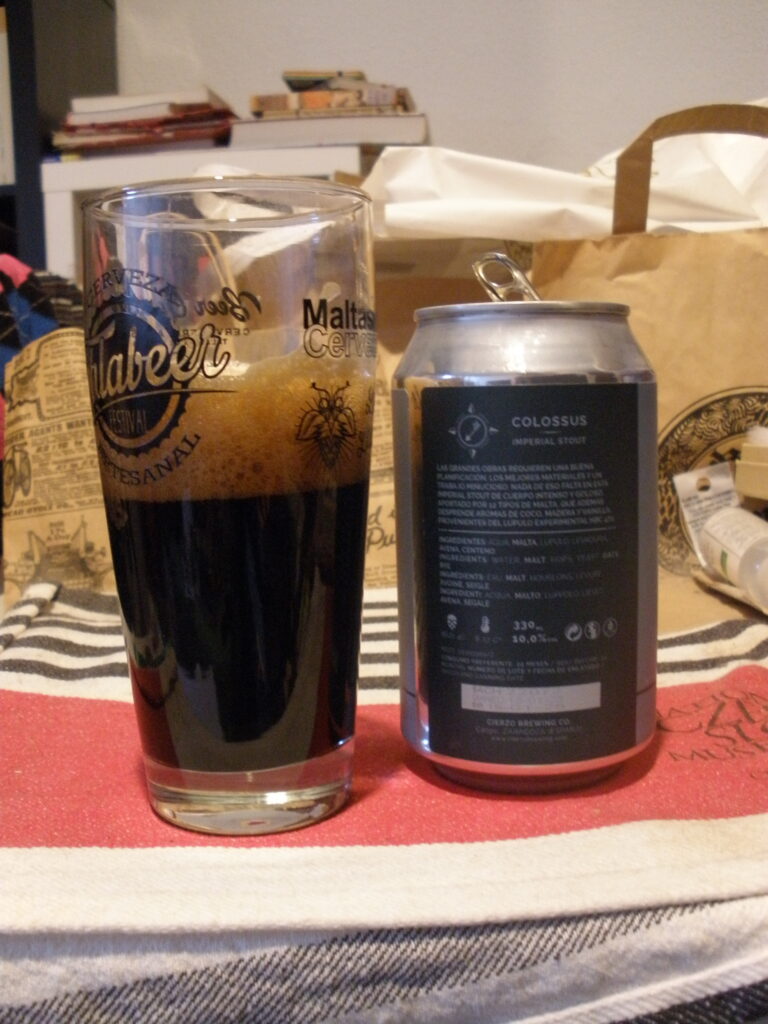
Supplier: La Mundial
Price: €4.70
It’s one of those times when the label is what gets a beer into your hand. I mean, look at that thing! Not that I’m a fan of the Clockwork Orange movie, I think it’s too easy to see as a glorification of assholery, but it’s so visually identifiable. And that’s the vision right there, staring out at you and daring you to risk your evening drinking a 7.4% DDH NEIPA. Octavo Arte knows what they’re doing with La Naranja Segoviana, at least in terms of attracting attention.
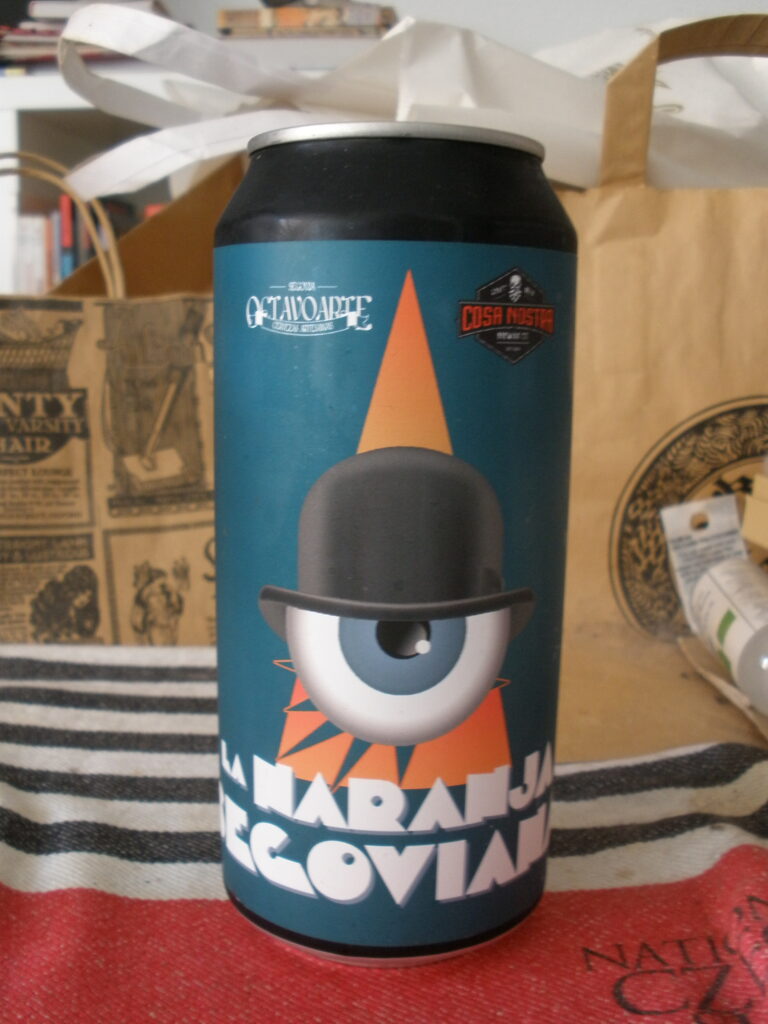
It’s a very light color, a little too dusty to be sunny and a reflection of the early summer day. There’s a very strong citrus aroma, even through my summer-air-dulled stuffy nose. Does it open the nasal passages a little? Maybe a little, in anticipation. It’s on the bitter side of the NEIPA scale, although it has a pretty solid body to it. It’s less juicy than some of its style, more piney and westward-leaning. But, that works just fine for the weather. The beer is smooth and a soft drink, but if you’re not careful with the sediment you get a good amount of sludge in the glass. It doesn’t affect the taste too much, although there is a little bit of a sting-y afterfeel. The infusion makes the beer more juicy looking, to be sure, but it isn’t that sweet and perky juicy NEIPA that some people love and love to look down on.
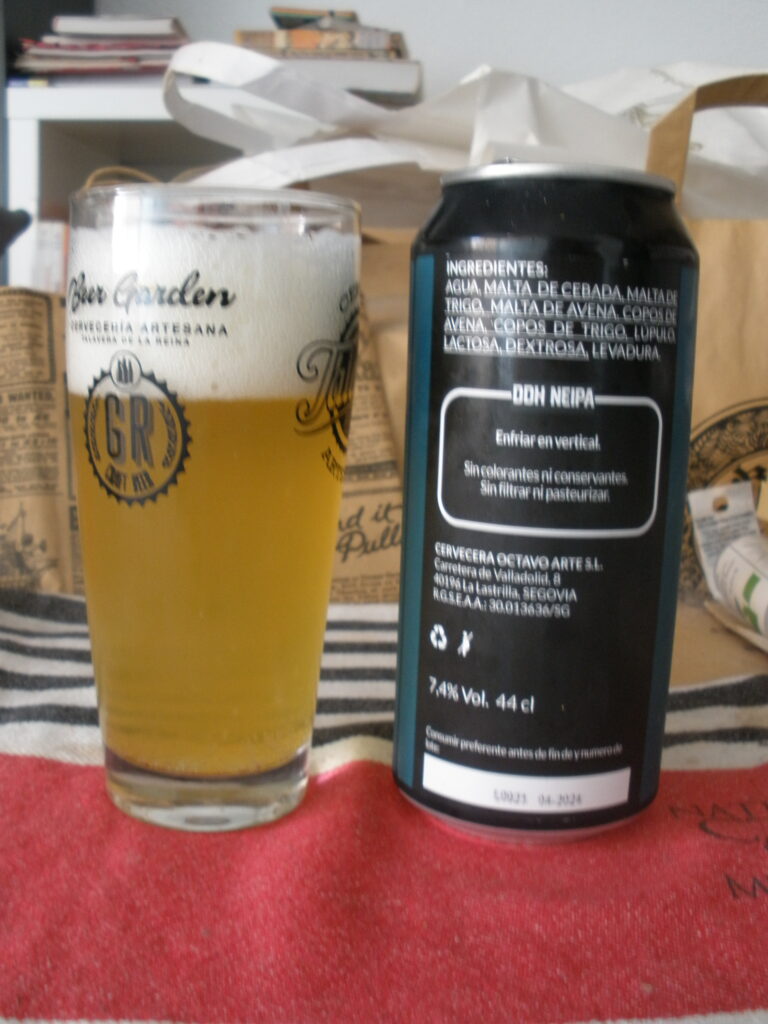
Supplier: Birra Y Paz
Price: €7.15
Hey, what’s that on the beer holiday calendar? (Where the hell is a good beer holiday calendar??) It’s German Beer Day! Germany has long had a special place in the beer drinker’s heart, as the home of high quality and drinkable beer, maybe not as fancy as Belgian, but trustworthy in its effects. Although there aren’t that many German craft beers floating around, some classics do make their way across the continent and populate the shelves of better stores. Schneider-Weisse is one that isn’t hard to find, and the weissbier style is right for the times…of excessive heat and dryness.
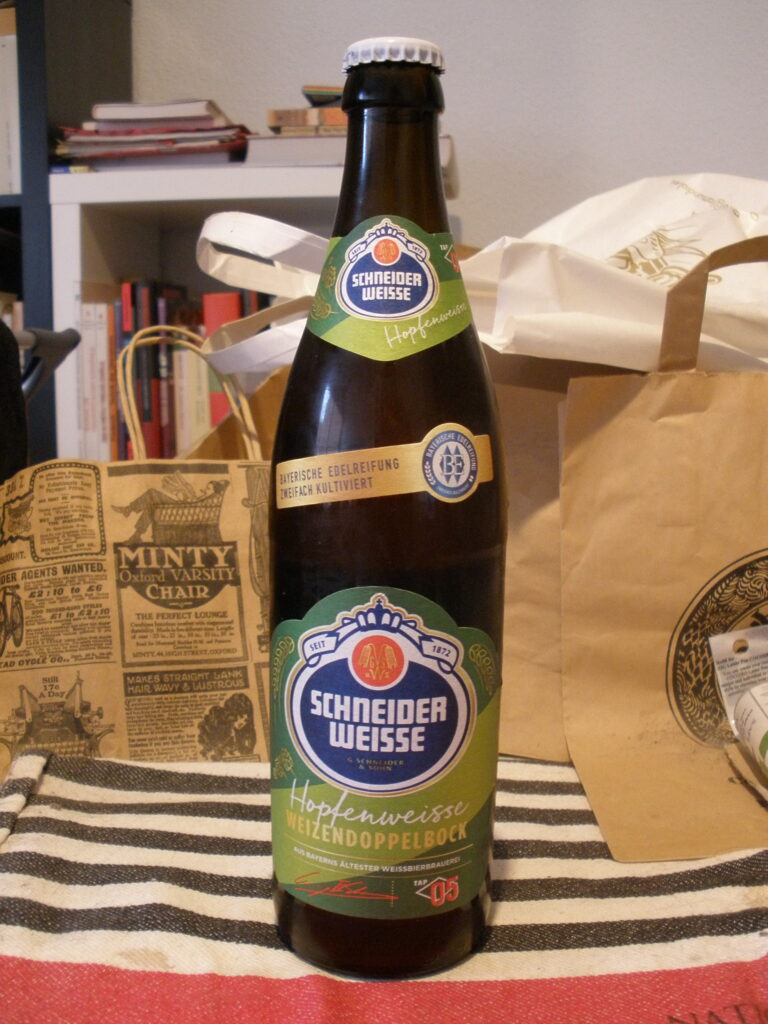
Although light and snappy looking, it delivers a thick malty aroma. The head is bubbly and controlled. The flavor is difficult to pin down – I get the dusty maltiness up front, but there’s a spiciness that I didn’t expect right beside it. The wheat is clear enough, and not that weird aftertaste some of the more commercial German ones have, but it also has a pretty strong essence of hops. It’s a pretty mouth-filling beer, which shouldn’t be a surprise from a doppelbock. In spite of that, it’s very soothing, with an almost medicinal flavor developing over time. There’s a much more bubbly texture than I’m used to from bock beers, but it’s not unwelcome. It has a satisfying modern feel along with a comforting whisper of tradition, and I think that’s what a lot of people would hope for when they look for a beer to celebrate on German Beer Day.
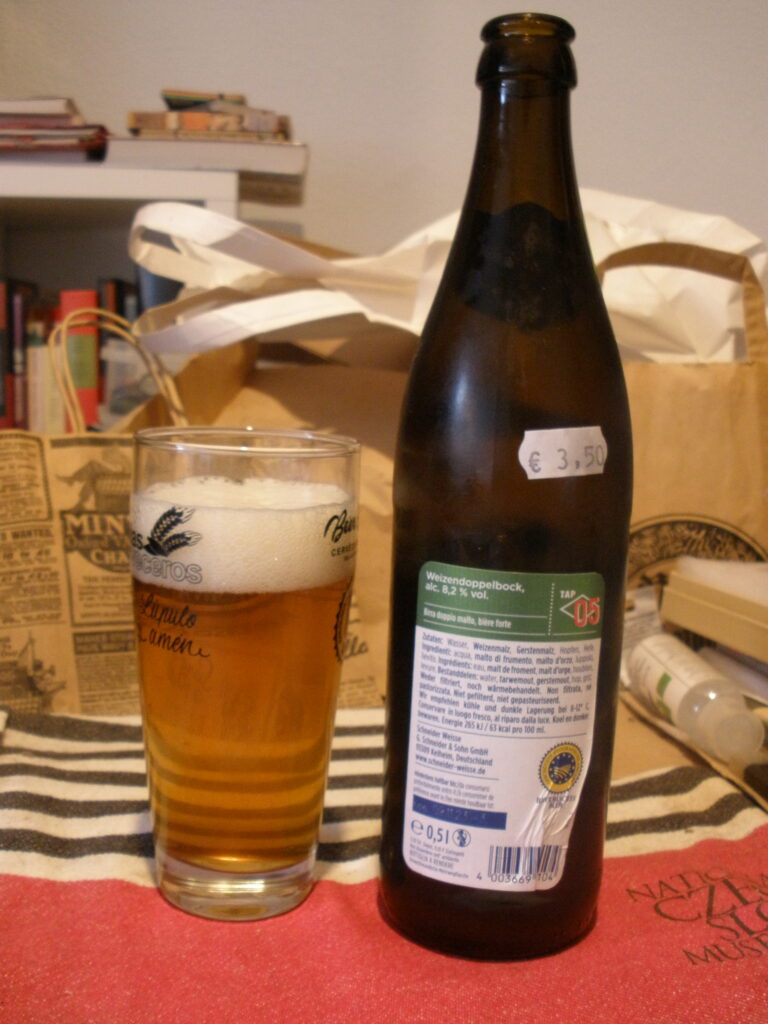
Supplier: Birra Y Paz
Price: €3.50
Times change but processes are always the same. It’s not so strange for businesses to close after a few years, some sooner than others, but it’s usually a little sad when they go. You get used to having them there in the background, even if you don’t patronize them super often. It’s going to be time to say goodbye to another beer store, this time near Retiro, so not too surprising that costs might catch up to them. It was a convenience, though, if you spent some time in the park and then went and got a good beer (or two) to take home. RIP, Birra Y Paz, these last few purchases will be your legacy. La Quince Vanilla Black Velvet is definitely something legacy worthy. My introduction to it was my first experience of glory with a craft beer.
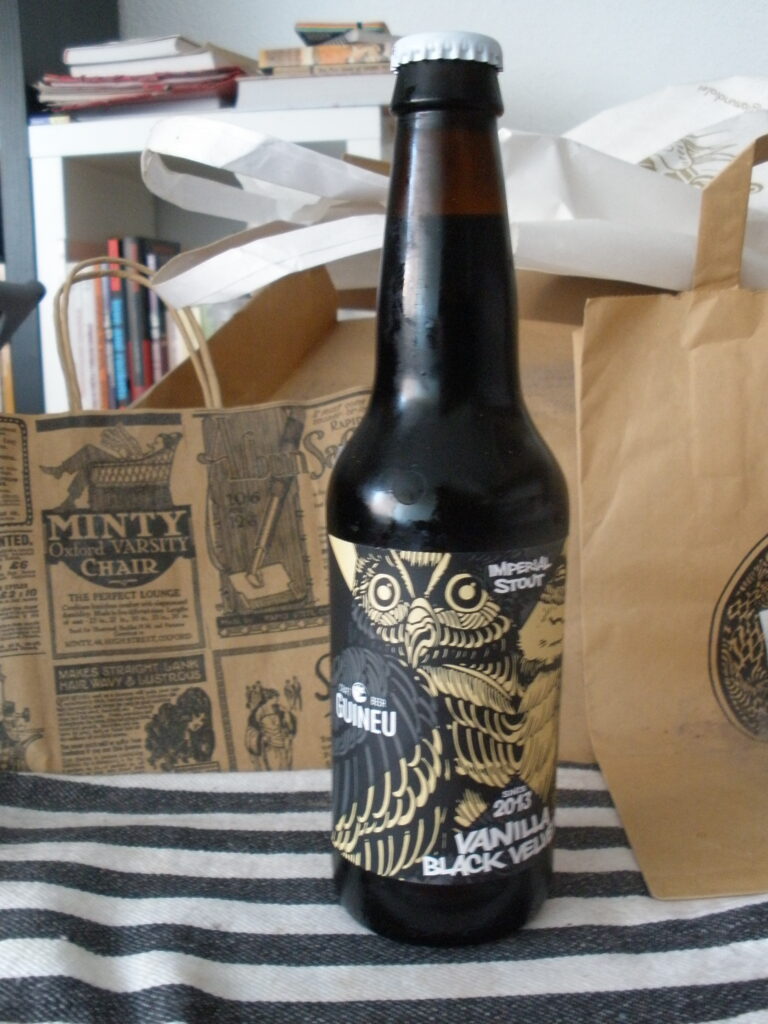
Rich and chocolate syrup smell, deep dark color, only light head. It’s malty and bitter, very stouty flavor, not as sweet as more recent pastry stouts, but with that touch of chocolate that blew my mind all those years ago. This particular batch or bottle is a little bit dusty, not smooth or syrupy, although it goes down easy and doesn’t have any distracting aftertaste or leavings. It has a more classic feeling to it, more of the echoes of beers of old being reflected in a craft brew than the craft beer shining its own dazzling light. This classic from La Quince (and Guineu) may have its off years and less successful variations, but it’s hard to say that it’s ever not good. The starry-eyed beeriness that I get from it awakens some nostalgia and some determined hope for the future. Good beer is here to stay and arriving over the horizon.

Supplier: Birra Y Paz
Price: €4.50
With practically summer temperatures upon us, doesn’t it sound good to have a fruity beer? Not one of those high citrus IPAs, or a sour and mouth punching lambic, but something a little less common. Who expects a banana beer? Although Spanish, it is from Yakka, it’s a Belgian triple style, which is really the most logical path to that kind of additive. It is kind of heavy – we are talking triple after all – at a hefty 10%. It is indeed a Platanazo. Hopefully, it won’t be too much for globally warmed spring.
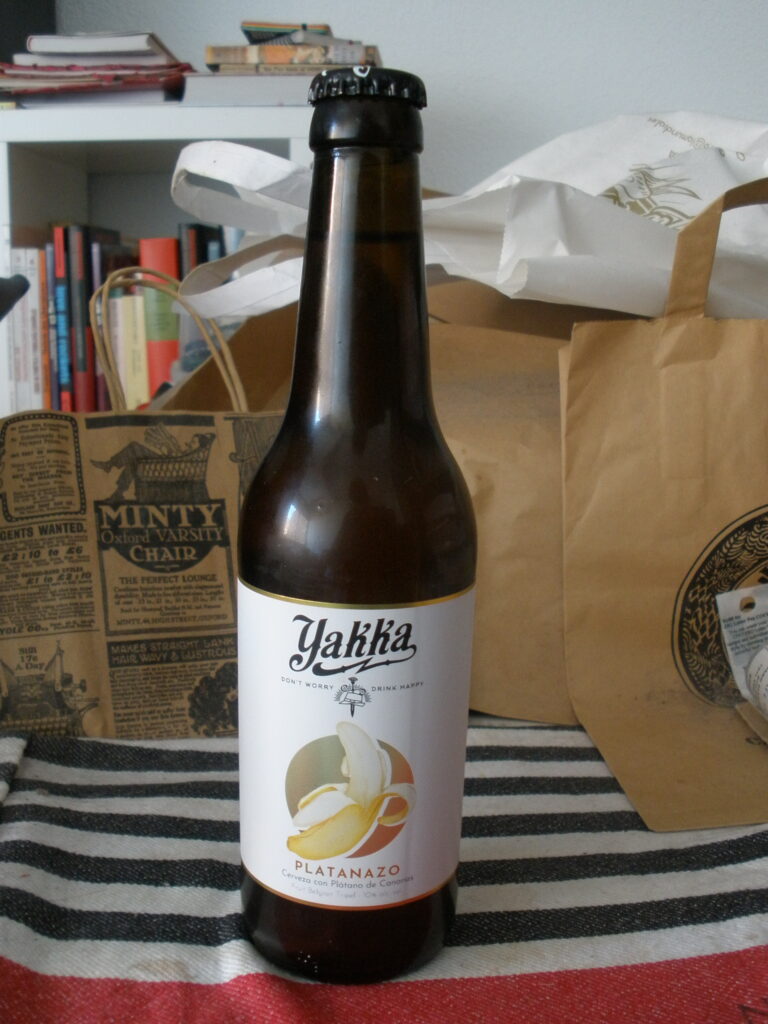
Extra foamy, a little bit more yellow than I was expecting, and with definite banana aroma. It’s pretty strong in the flavor too, although there’s a good mix of bitter and even sour alongside the banana bread. It’s not as smooth a feel as I thought it might be, it’s a crispier “crumb” on the bread part. At first it feels somewhat heavy in the mouth, but the flavor comes through gradually and lightens the mood quite a bit. It even makes me think that this is what a banana soda should be like, one of those “natural” ones. Citrus sodas, or just carbonated drinks, that promote themselves like that aren’t especially sweet. The sour reminds me that it is a Belgian style, with that little twang of aftertaste that I never quite get used to. Still, it’s a nice variation, and a good one to link the beer to its producer’s homeland.

Supplier: Hop Hop Hurra
Price: €3.55